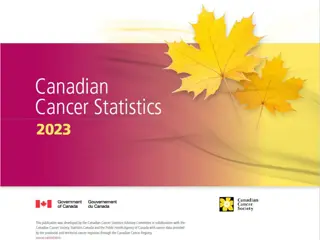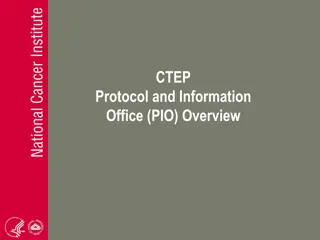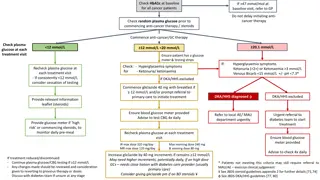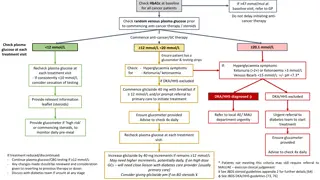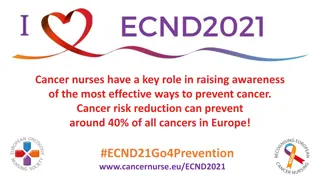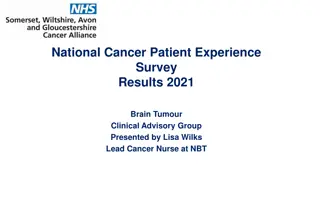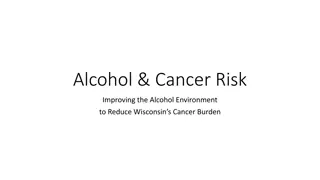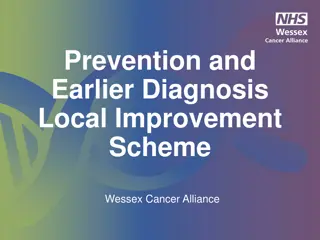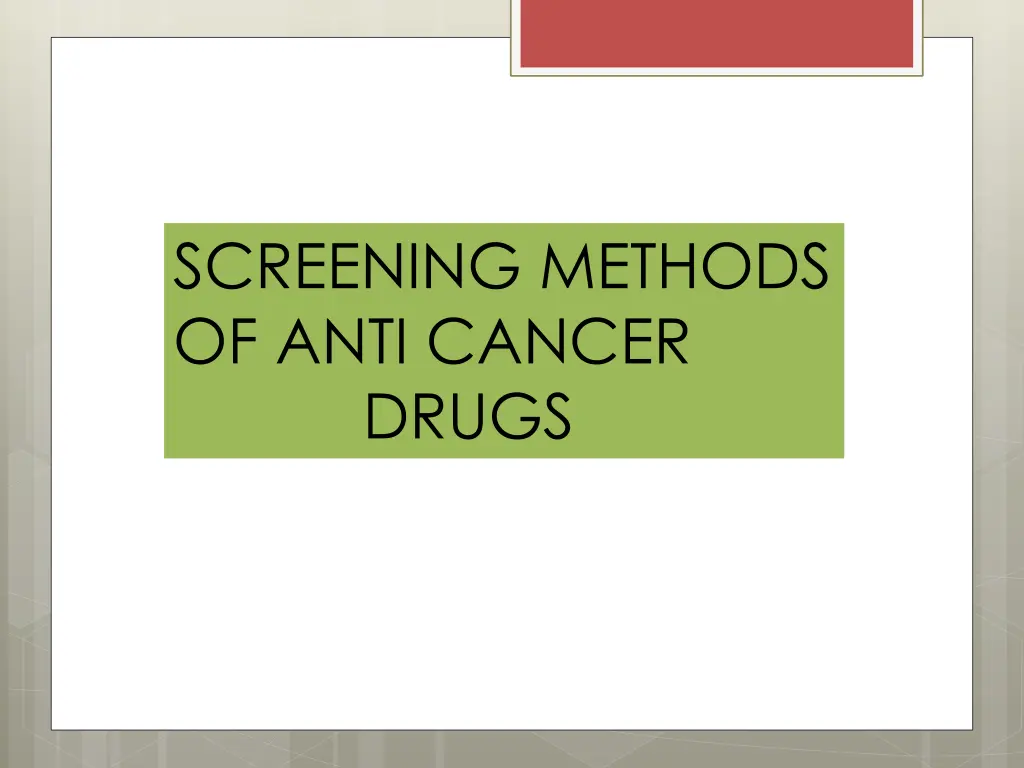
Methods of Screening Anti-Cancer Drugs
Explore various methods of screening anti-cancer drugs, including in vitro and in vivo techniques, classification of anti-cancer agents, and distinguishing cancer cells from normal cells. Learn about different types of drugs and their mechanisms of action in combating cancer. Discover essential screening methods involving cell lines, tumor pieces, and silico approaches.
Download Presentation

Please find below an Image/Link to download the presentation.
The content on the website is provided AS IS for your information and personal use only. It may not be sold, licensed, or shared on other websites without obtaining consent from the author. If you encounter any issues during the download, it is possible that the publisher has removed the file from their server.
You are allowed to download the files provided on this website for personal or commercial use, subject to the condition that they are used lawfully. All files are the property of their respective owners.
The content on the website is provided AS IS for your information and personal use only. It may not be sold, licensed, or shared on other websites without obtaining consent from the author.
E N D
Presentation Transcript
SCREENING METHODS OF ANTI CANCER DRUGS
Mrs. Neha Mali Dept of Pharmacology KLECOPH Hubballi
CANCER Cancer is a disease in which there is uncontrolled multiplication and spread within the body of abnormal forms of the body s own cells. HOW TO DISTINGUISH CANCER CELLS FROM NORMAL CELLS? Uncontrolled proliferation Differentiation & loss of function Invasiveness Metastasis
CLASSIFICATION ALKYLATING AGENTS Nitrogen mustards - Mechlorethamine Cyclophosphamide Isofamide Melphalan Ethylenimines & Methyl melamines - Hexamethylmelamine Thiotepa Alkyl sulfonates - Busulfan Nitrosoureas - Carmustine Streptozocin Triazenes - Dacarbazine
ANTIMETABOLITES Folic acid analogs - Methotrexate Pyrimidine analogs - 5-FU Purine analogs - 6-MP NATURALS PRODUCTS Vinca alkaloids - Vinblastin Vincristine Taxanes - Paclitaxel Antibiotics - Doxorubicin Mitomycin
SCREENING METHODS IN VITRO METHODS 1.Tetrazolium salt assay 2.Sulphorhodamine B assay 3.3H thymidine uptake assay 4.Dye exclusion tests 5.Clonogenic assays 6.Cell counting assays 7.Lung colony assay IN VIVO METHODS 1.DMBA induced mouse skin papillomas 2.MNU induced rat mammary gland carcinogenesis 3.DMBA induced rat mammary gland carcinogenesis 4.DMH induced colorectal adenocarcinoma in rat & mouse 5.AOM induced aberrant crypt foci in rat
METHODS INVOLVING CELL LINE/TUMOR PIECES IMPLANTATION 1.Hollow fiber technique 2.Use of xenografts 3.Nude mouse models 4.New born rat model 5.Transgenic mouse models IN SILICS METHODS 1.Virtual cancer therapy
1.Microculture Tetrazolium test Internationally accepted invitro method for anti cancer screening. Purpose: The multiwell plate scanning spectrophotometers can quickly measure large no. of samples with a high degree of precision and accuracy. PRINCIPLE: MTT assay utilizes a color reaction as a measure of viable cells. It is dependent on the cellular reduction of 3-(4,5-dimethyl thiazol- 2-yl)-2,5-di phenyl tetrazolium bromide, a tetrazolium salt to a blue formazan product by the mitochondrial dehydrogenase of viable cells. The intensity of blue colored formazan produced is directly proportional to the cell viability.
PROCEDURE Cells from particular cell line when in log phase are trypsinized. Counted in a haemocytometer, adjusted to appropriate density in suitable medium, inoculated in multiwell plates. Cells are treated with various conc. Of drugs for specified duration (1-4 days) MTT dye is added, incubated at 37 c for 4hrs in a carbondioxide incubator. Plates are then taken out, the dark blue colored formazan crystals are dissolved in isopropanol & read in ELISA reader at 570 nm
EVALUATION % Cell viability = OD of treated cells x 100 OD of control cells ADVANTAGES: Hundreds of samples can be run at a same time Various drug concentrations can be used to obtain a DRC IC 50 can be determined Large no. of drugs can be screened for antiproliferative activity.
2.SULPHORHODAMINE B assay PRINCIPLE This assay measures whole culture protein content and which should be proportional to cell number. Cell cultures are stained with a protein staining dye, sulphorhodamine B (SRB) SRB is a bright pink anionic dye that binds to basic amino acids of cells. PROCEDURE Cell lines are taken and incubated in 96 well microtitre plates. After incubation period cell monolayers are fixed with 10% trichloroacetic acid and stained for 30min, after which excess dye is removed by washing repeatedly with 1%acetic acid. The protein bound dye is dissolved in 10mM tris base solution for OD determination at 510nm using microplate reader.
EVALUATION % Cell viability = OD of treated cells x 100 OD of control cells ADVANTAGES Sensitive Simple Reproducible More rapid than MTT assay
1.DMBA INDUCED MOUSE SKIN PAPILLOMA PURPOSE DMBA (7,12-dimethyl benzanthracene) acts as initiator and 12-O- tetradecanoyl-phorbol-13-acetate (TPA) is used as promoter to induce skin papillomas & squamous cell carcinomas. PROCEDURE Mice is selected, weighed and marked The back of the mice is shaved Group 1 GROUP 3 Group 2 Control Acetone is received topically Both DMBA over period of 1 week and TPA twice weekly is given Like in group 2 and drug is given
Papillomas begin to appear after 6 to 7 weeks of application of TPA Weekly observations are made to monitor tumor development till experiment terminates after 18 weeks Percent tumor incidence and multiplicity of treatment group is compared with DMBA control group. The tumor incidence in this model is usually about 100% in DMBA controls
Effect of GA on tumor incidence and tumor volume in the control and experimental group of animals. Where, plate 1a control, plate 1b DMBA induced, plate 1c DMBA + GA treated mice, and plate 1d DMBA + 5-FU treated mice.
GROUPS TUMOR INCIDENC E 0 TUMOR APPEARE NCE - NO. OF TUMORS TUMOR VOLUME MORTALIT Y Control 0 0 0 GA alone 0 - 0 0 0 DMBA Induced 100 5 10.05 126 3 DMBA+ GA 60 9 2.09 18 0 Effect of GA on tumor incidence, tumor delay, tumor number and tumor volume of control and experimental group of animals.
EVALUATION The tumor incidence and the multiplication of the test drug is been compared with that of the control. And percentage inhibition is been evaluated. REQUIRMENTS Animals used- mice Experiment duration- 18 weeks Chemicals used 1.As initiator-DMBA 2.As promoter-TPA 3. Drug
2.MNU INDUCED RAT MAMMARY GLAND CARCINOGENESIS N-Methyl, N-nitrosurea induces hormone dependent tumor MNU induced rat mammary gland cancer model single intravenous injection of 50mg/kg body weight of MNU is given to SD rats. MNU induced of tumors are invasive & predominantly adenocarcinomas Drug efficacy is measured as percent reduction in adenoma incidence, multiplicity or percent increase in adenocarcinoma latency compared with that of carcinogen control. Usual tumor multiplicity ranges from 2-4 in this model
METHODS INVOLVING CELL LINE/TUMOR PIECES IMPLANTATION 1.NUDE MOUSE MODEL Nude mice have been widely used to test tumorogenicity of cells or for testing of anti cancer drugs. These mice are immunologically incompetent bcos of absence of thymus They neither show mitotic response in mixed lymphocyte reaction, nor generate cytotoxic effector cell Lack of T-helper and suppressor T cells alters the antibody response of animals to antigen.
REFERENCES 1.S.K GUPTA ., SCREENING METHODS pg no.418 - 431 2.Vimala Subramanian, Balaji Venkatesan, Anusha Tumala, Elangovan Vellaichamy., Topical application of Gallic acid suppresses the 7,12-DMBA/Croton oil induced two- step skin carcinogenesis by modulating anti-oxidants and MMP-2/MMP-9 in Swiss albino mice- SCIENCE DIRECT 3. Peter Houghton *, Rui Fang, Isariya Techatanawat, Glyn Steventon,Peter J. Hylands, C.C. Lee., The sulphorhodamine (SRB) assay and other approaches to testing plant extracts and derived compounds for activities related to reputed anticancer activity- SCIENCE DIRECT





